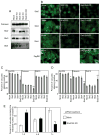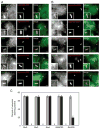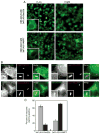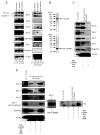Legionella pneumophila promotes functional interactions between plasma membrane syntaxins and Sec22b
- PMID: 20163564
- PMCID: PMC3164831
- DOI: 10.1111/j.1600-0854.2010.01050.x
Legionella pneumophila promotes functional interactions between plasma membrane syntaxins and Sec22b
Abstract
Biogenesis of a specialized organelle that supports intracellular replication of Legionella pneumophila involves the fusion of secretory vesicles exiting the endoplasmic reticulum (ER) with phagosomes containing this bacterial pathogen. Here, we investigated host plasma membrane SNARE proteins to determine whether they play a role in trafficking of vacuoles containing L. pneumophila. Depletion of plasma membrane syntaxins by RNA interference resulted in delayed acquisition of the resident ER protein calnexin and enhanced retention of Rab1 on phagosomes containing virulent L. pneumophila, suggesting that these SNARE proteins are involved in vacuole biogenesis. Plasma membrane-localized SNARE proteins syntaxin 2, syntaxin 3, syntaxin 4 and SNAP23 localized to vacuoles containing L. pneumophila. The ER-localized SNARE protein Sec22b was found to interact with plasma membrane SNAREs on vacuoles containing virulent L. pneumophila, but not on vacuoles containing avirulent mutants of L. pneumophila. The addition of alpha-SNAP and N-ethylmaleimide-sensitive factor (NSF) to the plasma membrane SNARE complexes formed by virulent L. pneumophila resulted in the dissociation of Sec22b, indicating functional pairing between these SNAREs. Thus, L. pneumophila stimulates the non-canonical pairing of plasma membrane t-SNAREs with the v-SNARE Sec22b to promote fusion of the phagosome with ER-derived vesicles. The mechanism by which L. pneumophila promotes pairing of plasma membrane syntaxins and Sec22b could provide unique insight into how the secretory vesicles could provide an additional membrane reserve subverted during phagosome maturation.
Figures






Similar articles
-
The Legionella pneumophila effector DrrA is sufficient to stimulate SNARE-dependent membrane fusion.Cell Host Microbe. 2012 Jan 19;11(1):46-57. doi: 10.1016/j.chom.2011.11.009. Cell Host Microbe. 2012. PMID: 22264512 Free PMC article.
-
Legionella effectors SidC/SdcA ubiquitinate multiple small GTPases and SNARE proteins to promote phagosomal maturation.Cell Mol Life Sci. 2024 Jun 5;81(1):249. doi: 10.1007/s00018-024-05271-7. Cell Mol Life Sci. 2024. PMID: 38836877 Free PMC article.
-
Legionella Manipulates Non-canonical SNARE Pairing Using a Bacterial Deubiquitinase.Cell Rep. 2020 Sep 8;32(10):108107. doi: 10.1016/j.celrep.2020.108107. Cell Rep. 2020. PMID: 32905772
-
SNAREs and membrane fusion in the Golgi apparatus.Biochim Biophys Acta. 1998 Aug 14;1404(1-2):9-31. doi: 10.1016/s0167-4889(98)00044-5. Biochim Biophys Acta. 1998. PMID: 9714710 Review.
-
Autophagy Evasion and Endoplasmic Reticulum Subversion: The Yin and Yang of Legionella Intracellular Infection.Annu Rev Microbiol. 2016 Sep 8;70:413-33. doi: 10.1146/annurev-micro-102215-095557. Annu Rev Microbiol. 2016. PMID: 27607556 Review.
Cited by
-
Direct targeting of membrane fusion by SNARE mimicry: Convergent evolution of Legionella effectors.Proc Natl Acad Sci U S A. 2016 Aug 2;113(31):8807-12. doi: 10.1073/pnas.1608755113. Epub 2016 Jul 19. Proc Natl Acad Sci U S A. 2016. PMID: 27436892 Free PMC article.
-
The capping domain in RalF regulates effector functions.PLoS Pathog. 2012;8(11):e1003012. doi: 10.1371/journal.ppat.1003012. Epub 2012 Nov 15. PLoS Pathog. 2012. PMID: 23166491 Free PMC article.
-
Atypical Legionella GTPase effector hijacks host vesicular transport factor p115 to regulate host lipid droplet.Sci Adv. 2022 Dec 16;8(50):eadd7945. doi: 10.1126/sciadv.add7945. Epub 2022 Dec 16. Sci Adv. 2022. PMID: 36525490 Free PMC article.
-
Sec22b and Stx4 Depletion Has No Major Effect on Cross-Presentation of PLGA Microsphere-Encapsulated Antigen and a Synthetic Long Peptide In Vitro.J Immunol. 2023 Oct 15;211(8):1203-1215. doi: 10.4049/jimmunol.2200473. J Immunol. 2023. PMID: 37638825 Free PMC article.
-
Phosphoinositides and the Fate of Legionella in Phagocytes.Front Immunol. 2020 Jan 30;11:25. doi: 10.3389/fimmu.2020.00025. eCollection 2020. Front Immunol. 2020. PMID: 32117224 Free PMC article. Review.
References
-
- Kagan JC, Roy CR. Legionella phagosomes intercept vesicular traffic from endoplasmic reticulum exit sites. Nat Cell Biol. 2002;4:945–954. - PubMed
Publication types
MeSH terms
Substances
Grants and funding
LinkOut - more resources
Full Text Sources
Miscellaneous

